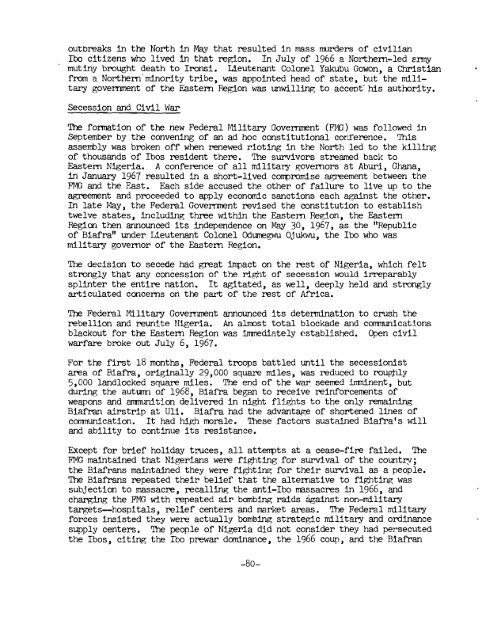3. - usaid
3. - usaid
3. - usaid
You also want an ePaper? Increase the reach of your titles
YUMPU automatically turns print PDFs into web optimized ePapers that Google loves.
outbreaks in the North in May that resulted in mass murders of civilian<br />
Ibo citizens who lived in that region. In July of 1966 a Northern-led srmy<br />
mutiny brought death to Ironsi. Ueutenant Colonel Yakubu Gowon, a Christian<br />
from a Northern'minority tribe, was appointed head of state, but the military<br />
govemnt of the Eastern Region was unwilling to acce~t'his authority.<br />
Secession and Civil W a r<br />
The formation of the new Federal Military Government (FJG) was followed in<br />
September by the convening of an ad hoc constitutional conference. This<br />
assembly was broken off when renewed rioting in the North led to the killing<br />
of thousands of Ibos resident there. The survivors streamed back to<br />
Eastern Nigeria. A conference of all military qovernors at Aburi, Ghana,<br />
in January 1967 resulted in a short-lived compromise agreement between the<br />
FT\G and the East. Each side accused the other of failure to live up to the<br />
agmernent and proceeded to apply economic sanctions each against the other.<br />
In late May, the Federal Govemnt revised the constitution to establish<br />
twelve states, including three within the Eastern Region, the Eastern<br />
Regicn then announced its independence on May 30, 1967, as the "Republic<br />
of Biafra" under Lieutenant Colonel Cdumegwu Ojukwu, the Ibo who was<br />
military governor of the Eastern Region.<br />
The decision to secede had great impact on the rest of Nigeria, which felt<br />
strongly that any concession of the right of secession would irreparably<br />
splinter the entire nation. It agitated, as well, deeply held and strongly<br />
articulated cancerns on the part of the rest of Africa.<br />
The Federal Plilitary Government announced its determination to crush the<br />
rebellion and reunite Nigeria. An almost total blockade and c~icatlons<br />
blackout for the Eastern Region was mediately established. Open civil<br />
warfare broke out July 6, 1967.<br />
For the first 18 months, Federal troops battled until the secessionist<br />
area of Biafra, originally 29,000 square miles, was reduced to rou@ly<br />
5,000 landlocked square miles. The end of the war seemed imninent, but<br />
during the autumn of 1966, Biafra began to receive reinforcements of<br />
weapons and amnunition delivered in night flights to the only remalninff<br />
Biafran airstrip at Uli. Biafra had the advantage of shortened lines of<br />
comnunication. It had high morale. These factors sustc.ilned Biafrats will<br />
and ability to continue its resistance,<br />
Except for brief holiday truces, all attempts at a cease-fire failed. The<br />
FMG maintained that Nigerians were fighting for survival of the county;<br />
the Biafrans maintained they were fighting for their survival as a people.<br />
The Biafrans repeated their belief that the alternative to fighting was<br />
subjection to massacre, recalling the anti-Ibo massacres in 1966, and<br />
charging the FTE with repeated air bombing raids eainst non-military<br />
targets-hospitals, relief centers and market areas. The Federal military<br />
forces insisted they were actually bombing strategic military and ordinance<br />
supply centers. The people of Nigeria did not consider they had persecuted<br />
the Ibos, citing the Ibo prewar dominance, the 1966 coup, and the Biafran
















